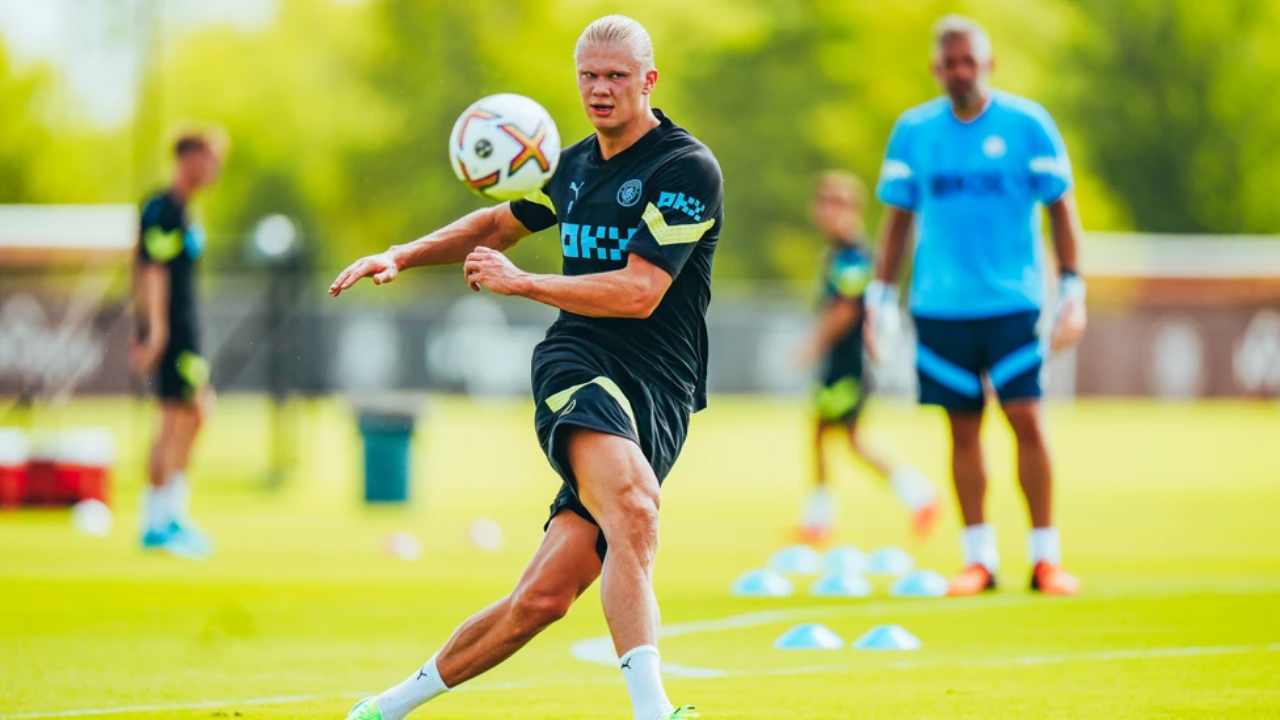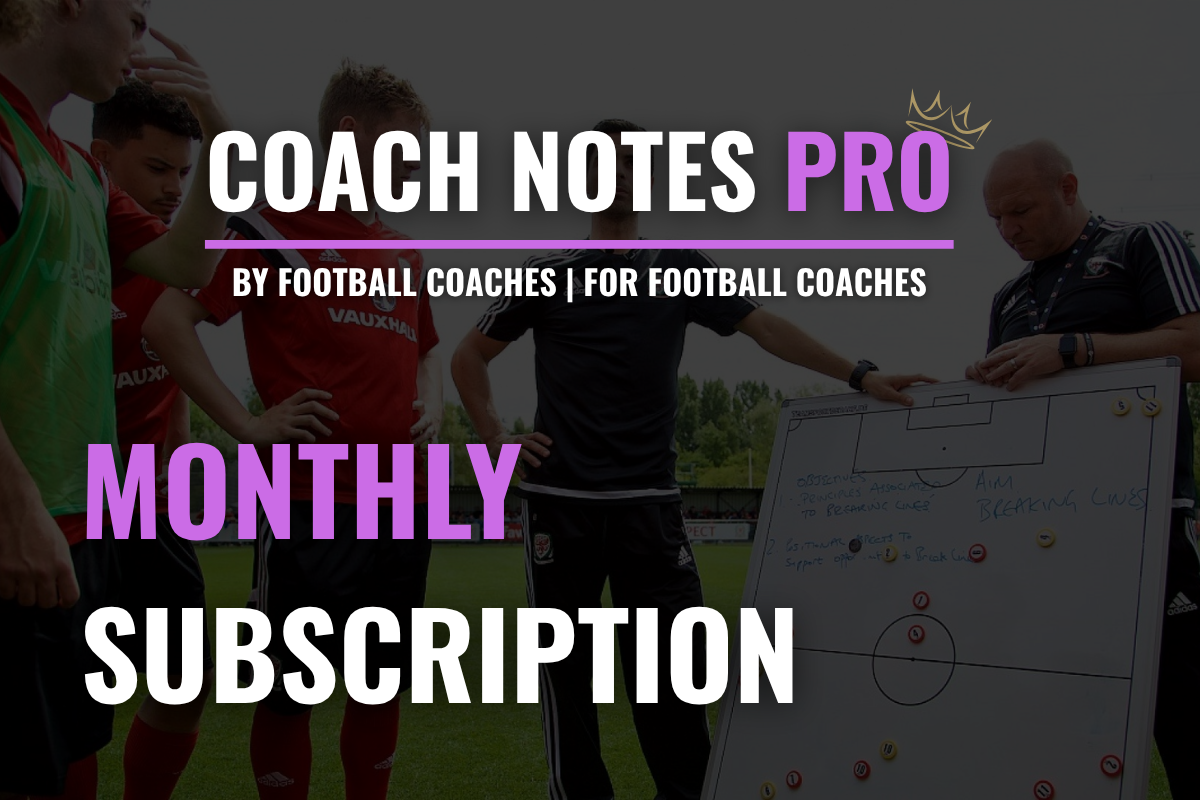
Striker Specific Coaching
This section features 8 key areas essential to developing strikers, each with tailored coaching tips and position-specific drills. Every skill is broken down to help strikers make better decisions and execute with confidence in 1v1 situations.
1v1 Finishing Coaching Tips
✅ Hit the Corners with Control, Not Power
Encourage players to prioritise placement over power. A low shot into the bottom corners is hard to reach for any goalkeeper. Focus on planting the non-kicking foot towards the target and striking through the ball with control using the inside or top of the foot.
✅ Exploit the Keeper’s Momentum
When the goalkeeper charges out, their own movement can be used against them. Teach strikers to spot this early and consider rounding the keeper or chipping over if they dive. Use feints or angled touches to draw them out and bypass the challenge.
✅ Refine First Touch & Body Positioning
A striker’s ability to finish often hinges on their first touch. Good preparation allows them to shoot early, shift the ball to open space, or manipulate the keeper. Train strikers to open their body, scan early, and take a touch that invites the finish.
✅ Master Finishes Under Pressure
Real match finishes are rarely clean. Simulate pressure in training using defenders or limited time constraints. Encourage strikers to stay composed, use quick touches, and take confident decisions even if that means going through the legs or playing a disguised shot.
✅ Build Decision-Making Through Repetition
Confidence comes from experience. Design high-repetition drills with variable outcomes. For example, changing the keeper’s behaviour or defender pressure. Reinforce that decision-making is a skill, and success comes from choosing the right technique at the right moment.
Finishing Technique Coaching Tips
✅ Selecting the Right Finishing Technique
Help strikers develop an adaptable finishing toolkit. Use the laces for power from distance or when time is limited. Use the instep for guided, composed finishes into the corners, especially in 1v1 or cutback scenarios. Use the outside of the foot for quick, instinctive flicks when under pressure or reacting to fast deliveries. Train in context and under pressure to support decision-making.
✅ Shooting Across Goal for Maximum Effect
Shooting across the goalkeeper is not only a high-percentage finish but also increases the chance of rebounds. This technique relies on clean body mechanics, striking low and hard with the laces or instep, ideally into the far corner. Rebound awareness is key, so pair strikers with supporting players trained to anticipate second balls.
✅ Mastering Finishing from Tight Angles
Strikers must be comfortable finishing when forced wide. Encourage players to shoot across the goalkeeper into the far post or surprise them with a near-post strike. Tight angles require a balance of precision and controlled power. Focus on body shape keeping the head and shoulders over the ball and reinforce repetition from both sides.
✅ Executing First-Time Finishes Under Pressure
First-time finishing eliminates the defender’s recovery window and disrupts the goalkeeper’s set position. Whether from crosses, rebounds or cutbacks, the emphasis should be on timing the run, body orientation, and clean contact. Coach players to adjust their technique based on ball height using the laces for volleys and the instep for ground passes.
✅ Shifting the Ball to Create the Shooting Lane
When confronted by a defender, strikers should use a quick shift with the outside or inside of the foot to create space. This movement opens up angles to shoot through legs, bend into corners, or fake to deceive both defender and keeper. Encourage fluid, one-motion shifts into the shot, especially near the edge of the box or when cutting inside.
Striker Movement Coaching Tips
✅ Timing Runs to Arrive, Not Just Be There
Effective movement into the box isn't just about getting forward, it's about arriving at the right time. Coach strikers to hold their runs until the delivery is initiated, adjusting based on the ball carrier’s body shape and tempo. Mistimed runs lead to offside calls or a lack of presence in dangerous zones. Use mannequins or defenders to simulate decision-making under real-time pressure.
✅ Exploiting the Blindside
When defenders are fixated on the ball, strikers should make arced or diagonal runs behind them on their blindside. Encourage players to vary the timing, some early runs to stretch the line, others delayed to catch defenders flat-footed. Highlight the importance of scanning and checking shoulder positions before accelerating.
✅ Curving Runs to Stay Onside
A well-timed curved run is essential to beat the offside trap while maintaining forward momentum. Focus on body shape: strikers should begin slightly wide, curve their run to watch the defensive line, and angle in toward goal just before the ball is played. This movement not only keeps them onside but also sets up a better angle for first-time finishes.
✅ Creating Separation with Double Movements
Encourage the use of “double movements” - feinting one way before accelerating the other. These are especially effective against tight marking. For example, a quick step toward the ball followed by a dart in behind can unbalance defenders. Train this using shadow defenders or live match scenarios to improve recognition and execution.
✅ Adapting Runs Based on Defensive Shape
Movement must be tailored to the opposition’s defensive structure. Against a low block, strikers might need to check toward the ball more often to link play. Against a high line, constant vertical threats in-behind are more effective. Emphasise that strikers must read the line, spacing, and intensity of the press before choosing their movement strategy.
Box Play & Cross Finishing Coaching Tips
✅ Attacking the First Zone
The first zone - typically the front post area - is a prime scoring location for quick cutbacks or near-post crosses. Train strikers to make darting runs across their marker, often starting from a central or far-post position. Emphasise timing and disguise: the run should begin late to avoid early tracking and should be explosive to gain a yard of space. Focus on redirecting the ball with minimal contact using the instep or outside of the foot.
✅ Timing Movement for Late Arrivals
Strikers who arrive late into the box often find themselves unmarked, as defenders are drawn toward the ball. Develop this by coaching delayed movements that sync with the delivery. Strikers can ghost in from deep, using a subtle acceleration after the initial cross has begun to unbalance defenders. Focus on scanning body language of wide players to cue the timing.
✅ Positioning for Rebounds & Second Balls
Not every cross leads to a clean finish. Coaches should emphasise that second-phase awareness is just as valuable. Strikers must anticipate blocked shots, misclearances, or goalkeeper spills. Ideal positions are around the penalty spot or just off the back of the centre-back. These are high-reward areas for reacting to loose balls and striking first time.
✅ Meeting Aerial Crosses with Directional Headers
Heading in the box is not just about power - it's about direction. Teach strikers to open their hips and attack the ball with their forehead, aiming for the corners rather than straight down the middle. Emphasise timing of the jump, eye on the ball, and using the neck for control. Simulate pressure by adding defenders or using foam shields during practice.
✅ Reading the Delivery
Strikers must learn to read the delivery -whether it’s a driven ball to the near post, a floated one to the back, or a pullback to the edge. Train players to scan the deliverer’s body shape and to anticipate the type of cross. Incorporate decision-making drills with varied deliveries to sharpen instinct and spatial awareness inside the penalty box.
Link-up & Hold-up Play Coaching Tips
✅ Establishing a Strong Body Position
Holding up the ball starts with body shape and positioning. Strikers should position themselves side-on to the defender, using one arm to feel for pressure and the other to receive the ball. Feet should be shoulder-width apart, with a low centre of gravity. This stance improves balance and protects the ball on contact. Emphasise holding the ball under pressure before making the next decision.
✅ Using One-Touch Lay-Offs to Link Play
Quick lay-offs are key to maintaining attacking momentum. Encourage strikers to develop awareness of supporting runs and to use one-touch passes to midfielders or overlapping full backs. The lay-off should be cushioned, not too firm or soft and ideally directed into space to allow forward movement. Practice in tight grids with passive pressure, then progress to live defenders.
✅ Drawing Contact to Win Fouls or Create Gaps
Experienced strikers use body contact not only to shield but to provoke fouls or manipulate defender positioning. Train players to recognise when to invite pressure using their back or side and when to roll off it. If the centre-back steps in aggressively, the striker can spin off or release the ball into the space they've vacated. Timing and awareness are critical.
✅ Receiving to Feet vs. Receiving on the Half-Turn
Not all hold-up play means back to goal. Strikers should learn when to pin a defender and receive to feet, and when to peel off and receive on the half-turn. Teach players to scan before receiving: if there's pressure behind, hold the ball and link play. If there's space, open up and turn to drive forward. Use mannequins and defenders to rehearse both scenarios.
✅ Spinning Off After the Pass
Once the striker has linked play or held up the ball, their job isn’t done. Encourage immediate movement to reposition, either dropping into space, spinning in behind, or making an angle for a return pass. This continuous movement makes them more difficult to mark and opens new lanes for progression. Reinforce "pass and move" habits in all drills.
Striker Pressing Coaching Tips
✅ Identifying Pressing Triggers
Strikers must understand when to initiate the press. Triggers include a poor first touch, a backpass to a defender under pressure, or a square ball across the back line. Train players to read cues in body language and ball movement. Use small-sided games where a poor touch or backward pass instantly activates the press, reinforcing reaction time and mental sharpness.
✅ Forcing Play into Traps
Pressing is not just about chasing, it’s about guiding. The striker’s body shape and approach angle should show the defender one option, usually the wide pass or weaker foot. Encourage players to press with curved runs, cutting off central passing lanes while forcing play into pre-agreed pressing zones. Use mannequins or cones in training to mark "traps" that guide the press.
✅ Controlling Pressing Angles
The angle of approach is crucial. A straight-line press can easily be bypassed with a simple pass. Train strikers to approach on an arc, closing down space while showing the ball into a predictable direction. Pressing diagonally allows teammates to step in and compress play, making recovery more efficient. Practise with scenarios where players must recover if the press is bypassed.
✅ Synchronising with the Midfield Line
Strikers are the first line of defence, but they must press in connection with the midfield behind them. Highlight the importance of vertical compactness and communication. If a striker presses but midfielders don’t step up, gaps open. Work on trigger-based team pressing where the entire unit reacts striker, attacking midfielder, and wide players to force high turnovers.
✅ Transitioning from Press to Possession
Winning the ball is only half the job. Strikers should immediately scan for options before or as they engage the press. If the ball is won, the first touch should be positive, either toward goal or into a supporting player. Create drills that end with a finishing opportunity 3–5 seconds after regaining possession to build the "win and exploit" mentality.
Striker Adaptability Coaching Tips
✅ Identifying the Type of Defensive Block
Recognising whether the opposition is defending with a high line, mid-block, or low block is essential. Against a high line, the emphasis is on timing runs in behind. Against a low block, strikers must be patient, use clever movements, and operate in tight spaces. Build tactical awareness by using freeze-frame analysis or game walkthroughs to teach players how to assess the defensive structure during transitions.
✅ Adjusting Movement to Exploit High Lines
When facing high defensive lines, the striker’s primary focus should be on depth - stretching the defence and timing runs beyond. Curved runs, double movements, and off-the-shoulder positioning become vital. Work on drills where strikers check short before spinning in behind, linking their runs to the timing of through balls or third-man combinations.
✅ Operating Between the Lines Against Low Blocks
When space in behind is limited, strikers must drop into pockets between the midfield and defensive lines. Receiving with their back to goal and playing off minimal touches is key. Encourage players to scan before receiving, use disguise, and develop quick link-up habits. Pair with midfielders in positional rondos and tight possession drills to simulate low block environments.
✅ Rotating with Supporting Attackers
Tactical flexibility often requires strikers to interchange positions with wingers or attacking midfielders. This rotation can unbalance defenders and open new channels of attack. Use training patterns where strikers and wide players alternate roles - dropping, overlapping, and underlapping to build automatic understanding of rotational patterns.
✅ Making Tactical Decisions Based on Game State
Adaptable strikers are situationally intelligent. They know when to press aggressively, when to slow the tempo, and when to pin centre backs to create space for others. Use match scenario training (e.g., 1-0 up with 10 minutes left) to coach decision-making. Players should be able to shift styles mid-match from target play to counter-attacking based on game context.
Decision Making Coaching Tips
✅ Anticipating the Second Ball
Intelligent strikers anticipate not just the initial play but what happens next. After a shot, deflection, or challenge, they must read the trajectory and timing of second balls. Teach players to stay alert, follow their shots, and position themselves centrally after crosses or cutbacks to exploit loose balls or rebounds. Pattern drills with frequent goalkeeper deflections are key for building instinct.
✅ Setting with the First Touch for a Shot
A good first touch doesn’t just control the ball, it sets up the next action. Strikers must learn to shift the ball into their shooting path or into space, depending on pressure and goal angle. First-touch setting should be purposeful: toward goal, away from the defender, or into space to exploit. Practice with passive then active defenders to shape this technical-tactical link.
✅ Choosing When to Shoot Through Legs
Shooting through a defender’s legs isn’t luck, it’s a deliberate decision when the path to goal is obscured. It’s particularly effective in close-range scenarios where the goalkeeper’s vision is blocked. Teach players to recognise open stances, wide leg positions, or moments when defenders lunge. Blend this into finishing from edge-of-box drills and 1v1 situations with a focus on low, driven shots.
✅ Recognising Shooting vs. Passing Moments
In high-pressure zones, knowing whether to shoot or square the ball can define games. Train strikers to lift their head before the strike assess goalkeeper position, teammate location, and angles. Use 2v1 drills, small-sided games, and game-scenario constraints to improve situational decision-making. Reinforce the value of unselfishness in front of goal without discouraging natural finishers.
✅ Reading Goalkeeper Body Language
Elite finishers observe subtle goalkeeper cues: shifting weight, leaning early, or overcommitting to one post. Strikers can exploit this with disguised finishes, chips, or reversing the shot direction. In training, use goalkeeper-specific scenarios where attackers are challenged to spot and react to these cues, both in isolation and with defenders involved.


































